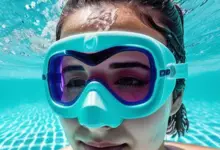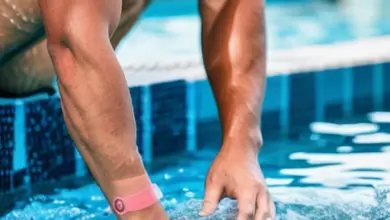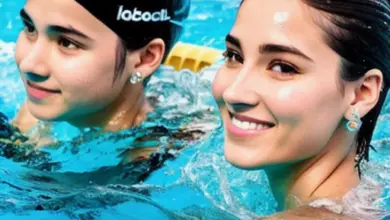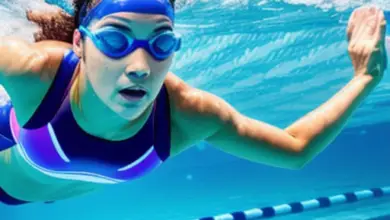How To Get Rid Of Foot Cramps While Swimming
Are you tired of getting sidelined by annoying foot cramps while enjoying a swim? Do those sudden, painful sensations in your feet ruin your groove in the pool or ocean? You’re not alone: many swimmers have experienced this dreadful inconvenience at some point in their aquatic adventures. Luckily, you’ve come to the right place. In this blog post, we’re going to dive into the key factors causing foot cramps while swimming and share practical tips to help you prevent or alleviate this bothersome issue. Get ready to streamline your swimming experience and keep those pesky foot cramps at bay, so you can glide through the water with ease.
Hydrate adequately before and during swimming
There is no denying that foot cramps during swimming can be both painful and annoying. As swimmers, we want to enjoy our time in the water without these interruptions. The good news is that you can take several preventive measures to reduce your chances of experiencing foot cramps while swimming. One of the most important steps to follow is proper hydration.
Hydration plays a crucial role in preventing foot cramps, as it helps maintain the balance of electrolytes in the body. Electrolytes, including sodium, potassium, and calcium, are responsible for regulating muscle contractions. If your body is dehydrated or low on these essential minerals, you are more likely to experience cramping.
To adequately hydrate before and during swimming, follow these simple tips:
1. Drink plenty of water throughout the day leading up to your swim session. Aim for at least a liter of water 2-3 hours before your swim, ensuring that you drink small amounts regularly rather than large gulps.
2. Monitor your urine color, a pale yellow hue indicates that you are well-hydrated.
3. Include electrolyte-rich drinks or supplements in your hydration routine, especially if you sweat heavily during exercise.
4. Listen to your body and adjust your water intake accordingly. If you feel thirsty, it’s already a sign that you’re not drinking enough.
5. During your swim sessions, make sure to take regular breaks to hydrate properly. It might be a good idea to have a water bottle handy at the poolside.
Enjoying your swim without the discomfort of foot cramps takes a bit of effort and commitment to maintaining proper hydration levels. Staying well-hydrated before and during your swim will not only help prevent foot cramps but also improve your overall performance and well-being. So, drink up, and enjoy your time in the water!
Avoid caffeinated beverages and alcohol before swimming
Foot cramps can be a real nuisance during swimming, causing discomfort and disrupting your training session. While there are several factors that may contribute to foot cramps, a proactive approach to prevention can help minimize their occurrence. One way to avoid foot cramps while swimming is to limit your intake of caffeinated beverages and alcohol before hitting the pool.
Caffeinated drinks such as coffee and tea can lead to dehydration, as caffeine acts as a mild diuretic, increasing urine production and fluid loss. Dehydration can cause muscle cramps, which, in a swimmer’s case, often affect the feet and calves. It is important to drink plenty of water throughout the day and especially before your swim to maintain proper hydration levels. Try swapping out caffeinated beverages for water or electrolyte-rich sports drinks to help keep your body properly hydrated and your muscles functioning optimally.
Similarly, alcohol also causes dehydration by increasing urine production and impairing your body’s ability to rehydrate. Consuming alcohol before swimming can not only make you more prone to foot cramps, but also affect your ability to swim safely and efficiently. If you plan to indulge in a glass of wine, be sure to do so well in advance of your swim session and compensate by drinking additional water to maintain proper hydration levels.
Avoiding caffeinated beverages and alcohol before swimming can help reduce the likelihood of foot cramps. Instead, focus on keeping your body properly hydrated through sufficient water intake and consider incorporating electrolyte-rich sports drinks for optimal muscle function. With these simple adjustments, you can keep foot cramps at bay and enjoy a more comfortable and productive swim.
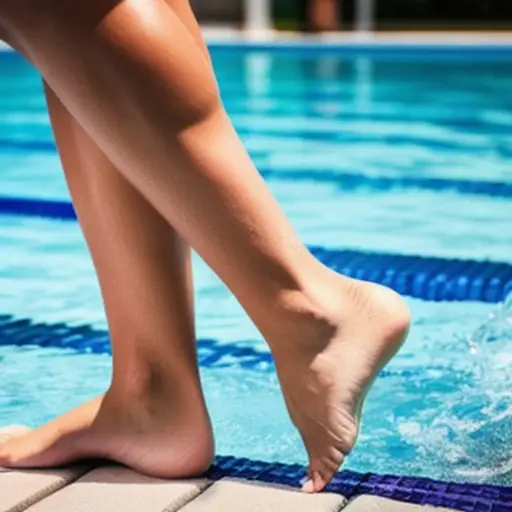
Incorporate pre and post-workout stretches for the calf and foot muscles
Foot cramps can be a major hindrance when it comes to enjoying a good swim session. However, incorporating proper pre and post-workout stretches targeting the calf and foot muscles can effectively reduce the occurrence of these painful experiences. By following these simple tips, swimmers can prevent foot cramps and enjoy a more comfortable time in the water.
Firstly, it’s important to maintain good hydration before, during, and after swimming. This involves not only drinking water but also replenishing electrolytes and consuming a nutrient-rich diet to support the body’s needs. Stretching should also be an integral part of any swimmer’s warm-up and cool-down routine, both on land and in the pool.
Effective stretches that target the calf and foot muscles include standing with one leg in front of the other and leaning against a wall, bending the front leg while keeping the back leg straight to stretch the muscle in the lower back leg. Another useful stretch involves bending both knees while keeping the heel of the back leg on the floor to stretch the muscle in the back lower leg.
Swimmers can also try standing with the toes of the front foot raised against a step or wall and bending both knees to stretch the sole of the front foot. Rolling the foot over a golf or hockey ball can also provide relief, but if it’s too painful, doing so in warm water may help the muscles relax more.
Incorporating appropriate stretches for the calf and foot muscles before and after a swim, maintaining good hydration, and following a healthy diet can effectively prevent foot cramps and allow swimmers to fully enjoy their time in the water.
Consider yoga for increased flexibility in the lower legs
Practicing Yoga to Increase Flexibility and Prevent Foot Cramps While Swimming
Swimmers often experience foot and calf cramps while swimming, which can be both painful and disruptive to their training or workout sessions. One effective way to prevent these cramps and increase flexibility in the lower legs is by incorporating yoga into one’s exercise routine. Yoga has been proven to enhance flexibility, balance, and strength, making it an ideal practice for swimmers.
By participating in weekly yoga classes or practicing yoga poses at home, swimmers can significantly improve the flexibility in their feet and lower legs, helping to ward off any painful cramps. A few yoga poses that are particularly beneficial for swimmers include Downward-Facing Dog, which stretches the calves and Achilles tendons; Seated Forward Bend, which targets the hamstrings and calves; and Reclining Hand-to-Big-Toe pose, which focuses on the feet, ankles, and calves.
Moreover, taking up yoga as a complementary practice to swimming provides swimmers with a holistic approach to exercise, targeting both the mind and body. It allows them to focus on their breathing, posture, and muscle strength, which can be beneficial for improving their swimming performance in the long run.
In conclusion, incorporating yoga into one’s exercise regimen can play a significant role in preventing foot and calf cramps, as well as improving flexibility and overall fitness. Whether attending a yoga class or practicing at home, swimmers should ensure they practice these poses consistently to reap the benefits and fend off frustrating cramps while swimming.

Choose appropriate footwear for swimming
Foot cramps can be quite painful and annoying, especially when they occur during swimming. To prevent these uncomfortable interruptions and enjoy your time in the pool, it is essential to choose the appropriate footwear designed for swimming. There are several factors to consider when selecting the right shoes for this purpose.
First, opt for swimming shoes that provide adequate support and cushioning for your feet. This will not only help prevent foot cramps but also protect your feet from any possible injuries caused by the hard pool floor or other underwater hazards. A well-cushioned shoe can also absorb shock and reduce impact on your feet, which helps minimize the chances of cramping.
Next, choose shoes that offer good traction in wet conditions. This will help you maintain stability while walking along slippery pool decks, preventing any accidental slips or falls that could lead to injured feet. Shoes with a non-slip sole are usually the best choice for swimmers since they provide excellent grip on wet surfaces.
Furthermore, breathable and quick-drying materials are essential when selecting swimming shoes. These features will allow your feet to stay dry and comfortable, reducing the likelihood of developing fungal infections, which can also trigger foot cramps. Materials like mesh or neoprene are ideal for swimming shoes, as they are lightweight, water-resistant, and allow for proper air circulation.
Finally, ensure a snug yet comfortable fit. Loose shoes may slip off while swimming, while shoes that are too tight can impair blood flow and cause cramps. Make sure to try on different sizes and styles to find the perfect fit for your feet while swimming.
By choosing the right footwear, you can avoid those dreaded foot cramps and focus on your swimming workout, allowing you to maintain peak performance and enjoy your time in the water.
Take breaks from sitting or standing for prolonged periods of time
Foot cramps can be a major hindrance for swimmers, disrupting their rhythm and causing discomfort. There are several ways swimmers can prevent foot cramps. Firstly, staying hydrated is crucial. It’s essential to not only drink water but also consume electrolytes and eat the right foods before and after training to keep the muscles limber and help the body stay in top shape (U.S. Masters Swimming).
Another important preventative measure is stretching. Incorporating regular stretching exercises into warm-up and warm-down routines for both pool and land-based sessions will help maintain flexibility in the muscles and reduce the likelihood of cramps. There are various calf and foot stretches that can be beneficial for swimmers, such as the calf stretch, soleus stretch, plantar fascia stretch, and foot roll (Masters Swimming Advice).
Another vital aspect is avoiding prolonged periods of sitting or standing, which can contribute to muscle stiffness and cramping. Swimmers should make sure to take breaks from such sedentary positions and get up to walk around or do some gentle stretches. This helps to keep muscles flexible and reduces the chances of cramping when jumping into the pool.
In addition to these preventative measures, swimmers should also focus on staying in shape through regular exercise routines and maintaining a healthy lifestyle, as this plays a significant role in the body’s ability to fend off cramps. Moreover, joining a weekly yoga class can provide additional stretching and flexibility exercises that may further help in reducing the incidence of foot cramps while swimming (U.S. Masters Swimming).
By taking these simple steps and incorporating them into their daily routines, swimmers can significantly reduce the likelihood of experiencing foot cramps during their practice sessions and competitive events.
Gradually warm up before swimming
Swimming is a great way to stay fit and have fun, but foot cramps can quickly put a damper on your workout. Follow these seven tips to avoid foot cramps and enjoy a pain-free swim.
1. Hydrate before, during, and after practice. Dehydration can cause cramping, so be sure to drink water or electrolyte-filled sports drinks to maintain proper hydration levels.
2. Stretch before swimming. Stretching exercises, such as calf stretches and ankle flexor stretches, can help to prevent foot cramps by maintaining flexibility in your muscles. Incorporate these into your pre-swim routine to reap the benefits.
3. Warm up gradually. Start your swim session with slow-paced warm-ups of at least 1000 yards. This will help your muscles and ligaments to gently ease into the movements of swimming, reducing the risk of cramping.
4. Maintain overall body flexibility. Incorporating yoga or other activities involving stretching into your weekly routine can help develop flexibility in your lower legs, which can aid in warding off foot and calf cramps.
5. Incorporate strength training exercises into your workout. Increased muscle strength will not only help prevent cramps but will also improve your overall swimming performance.
6. Be mindful of your daily activities. Swimmers who sit at a desk all day may be more prone to cramps, so make an effort to get up and move around throughout your workday.
7. Ensure proper nutrition. Keeping your diet balanced and nutrient-rich can also help reduce the likelihood of foot cramps while swimming.
By following these strategies, you’ll be able to avoid foot cramps and enjoy a pain-free swimming experience. Happy swimming!
Stay in overall good physical shape
Title: Stay in Overall Good Physical Shape to Prevent Foot Cramps While Swimming
Swimming is an excellent form of exercise and provides a full-body workout. However, foot cramps can hinder the swimmer’s ability to perform efficiently and enjoy their time in the pool. To prevent foot cramps and have a satisfying swimming experience, it is crucial to maintain overall good physical shape. Here are a few helpful tips to follow.
First, hydrate properly. Adequate hydration is essential not just during swimming but also throughout the day (U.S. Masters Swimming). Be sure to consume enough water and electrolyte-infused beverages to keep your muscles limber. Also, be mindful of your diet, and ensure you eat nutrient-rich foods to fuel and support your muscles before and after training sessions.
Second, incorporate regular stretching and flexibility exercises (Masters Swimming Advice). Warm-up and warm-down routines, both in the pool and on land, should include targeted stretches to loosen the calf and foot muscles. It is recommended to hold stretches for two minutes, divided into intervals of 10, 20, or 30 seconds.
Moreover, engaging in weekly yoga classes can not only enhance your flexibility but also benefit your overall physical fitness (U.S. Masters Swimming). Another valuable measure is to be mindful of your activity level when not swimming; taking breaks from work and walking around can help ward off cramps.
In conclusion, staying in overall good physical shape will significantly reduce the chance of foot cramps while swimming. Ensuring proper hydration, nutrition, muscle flexibility, and overall physical activity contributes to a cramp-free and enjoyable swimming experience.
9. Avoid overexertion during swimming
Foot cramps while swimming can be a painful and frustrating experience, often striking mid-pool and forcing swimmers to stop their workout or training session. These cramps can be caused by various factors, such as dehydration, poor conditioning, or inadequate warm-ups and stretches. By understanding the roots of foot cramps and incorporating some effective measures, swimmers can significantly reduce the occurrence of these unpleasant interruptions.
One of the key factors in avoiding foot cramps during swimming is maintaining proper hydration levels. Swimmers should drink water consistently throughout the day, especially before and after swim sessions. Adequate hydration helps to keep muscles limber and less prone to cramping. In addition to hydration, swimmers should also incorporate sufficient stretching into their routines, focusing on the muscles in the calves and feet. Ankle flexibility and calf stretches are particularly crucial in warding off foot cramps.
Warm-Up and Stay Active
A proper and gradual warm-up before swimming can help prevent foot cramps by slowly acclimating the muscles to the demands of the activity. Swimmers should ensure they spend enough time warming up their muscles at a slow pace before diving into more intensive exercises. Yoga is also an excellent way to increase flexibility and help avoid foot cramps. In addition to warm-ups, staying active and mobile throughout the day can help prevent cramping, especially for those who spend their workdays sitting at a desk.
Monitor Your Exertion Level
Finally, swimmers should be aware of their exertion levels while in the pool. Overexertion can lead to muscle fatigue and increased susceptibility to cramping. To avoid this, swimmers should gradually build up their endurance and pay attention to their body’s signals. Incorporating rest periods or adjusting the intensity of the swim session as needed can help prevent both overexertion and the resulting foot cramps.
Maintaining proper hydration, incorporating appropriate stretching and warm-ups, staying active throughout the day, and monitoring exertion levels can help swimmers avoid the inconvenience and pain of foot cramps while swimming.
Incorporate electrolyte-rich foods or supplements in your diet
Swimming is an excellent full-body workout; however, foot cramps can sometimes interrupt this enjoyable and heart-pumping activity. One effective way to prevent and alleviate foot cramps while swimming is by ensuring that your body has enough essential electrolytes. Electrolytes play a crucial role in muscle contraction, and when there’s an imbalance, cramping can occur.
A well-balanced diet with electrolyte-rich foods is an excellent way to maintain the adequate levels needed for muscle function. It is important to consume sufficient amounts of sodium, potassium, magnesium, and calcium – popular electrolytes that can be found in various foods.
Bananas and avocados are both great sources of potassium and magnesium. These creamy, delicious fruits not only offer the necessary nutrients but are also easy to incorporate into a snack or meal. Similarly, sweet potatoes provide potassium, magnesium, and calcium while offering additional vitamins and fiber.
For a hydrating and electrolyte-rich drink, consider coconut water as your go-to thirst quencher. This beverage is especially beneficial for swimmers, as it contains all the essential electrolytes in significant amounts, replenishing the body after a vigorous swim session.
Finally, consuming Greek yogurt, bone broth, and an assortment of leafy greens like kale, spinach, and broccoli can further aid in preventing foot cramps. Greek yogurt is rich in calcium essential for muscle function, while bone broth and leafy greens supply ample amounts of magnesium.
In conclusion, foot cramps while swimming can be prevented and alleviated by incorporating electrolyte-rich foods into your diet. Consuming these nutritious options will not only help keep cramps at bay, but also support overall muscle and body health.


